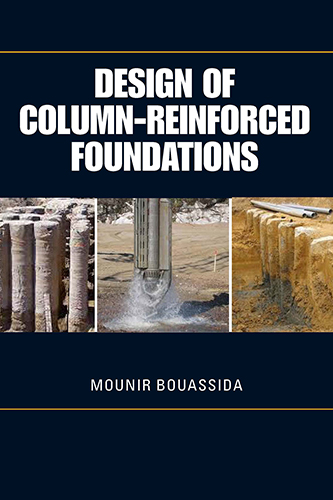Design of Column-Reinforced Foundations
$109.95
By Mounir Bouassida
Hardcover, 6×9, 240 pages
ISBN: 978-1-60427-072-3
September 2016
Description
The design of foundations on reinforced soil by columns is discussed within a general framework where several aspects are taken into consideration: modeling of reinforced soil, bearing capacity, settlement, acceleration of consolidation, and improvement of soil characteristics with selected case histories. Unlike existing books on unique improvement techniques (deep soil mixing, stone columns, sand compaction piles) that focus on installation and equipment issues, this one-of-a-kind, full-color guide details the design. It is an important work for all in the geotechnical field, including practitioners, academics, and students.
Key Features
- Introduces a novel methodology of design for all column-techniques through an optimized improvement area ratio determined by combining the bearing capacity and settlement verifications that constitute an original result
- Provides case histories that show this optimized design is cost effective compared to existing methods based either on bearing capacity or settlement considerations
- Shows the value of the optimized design achieved by elaborated columns through software already in use by geotechnical engineers
- Analysis of the behavior of reinforced soil by columns, carried out by finite element and finite difference codes, subjected to various vertically loaded structures, shows the effectiveness of floating columns that can be adopted for reinforcement of thick compressible deposits
- Rationally handles the design of column-reinforced foundations from modeling up to the study of behavior predicted by numerical analysis and assessed by field test results
About the author(s)
Mounir Bouassida is a professor of civil engineering at the Ecole Nationale d’Ingénieurs de Tunis (ENIT) of the Université de Tunis—El Manar where he earned his B.S., M.S., Ph.D., and doctorate of sciences diplomas, all in civil engineering. He currently teaches soil mechanics and limit analysis courses at ENIT and the Polytechnic School of Tunisia. He is the director of the Research Laboratory in Geotechnical Engineering and has supervised 13 Ph.D. and 29 master of science graduates. His research focuses on soil improvement techniques and behaviour of soft clays.
Dr. Bouassida is the co-author of 42 papers in refereed international journals; 126 papers, including 17 keynote lectures from international conferences; and a book related to testing in soil mechanics. He is a member of the editorial committees of the journal Ground Improvement (ICE), the Journal of Geotechnical and Geological Engineering, Infrastructure Innovative Solutions (Springer), and International Journal of Geomechanics (ASCE). He is also an active reviewer in several international journals, including the Journal of Geotechnical and Geoenvironmental Engineering and the Canadian Geotechnical Journal.
As a 2006 Fulbright scholar, Professor Bouassida created a novel methodology for the design of foundations on reinforced soil by columns. He was awarded the 2006 S. Prakash Prize for Excellence in the practice of geotechnical engineering. In 2008, Bouassida launched a Tunisian consulting office in geotechnical engineering, SIMPRO. He is a co-developer of the software Columns 1.01 used for designing column-reinforced foundations. Prof. Bouassida held the office of the vice president of ISSMGE for Africa (2005–2009). He benefited from several grants as a visiting professor in the USA (CSUS and MIT), France (ENPC, Paris, Ecole Centrale de Lille, and Ecole des Mines Douai), Belgium (Catholic University of Louvain-La Neuve), and Australia (University of Newcastle).
Reviews
“This book summarises the academic and practising experience of the author and provides some advice regarding the design of foundations using stone columns in particular, and soil mix columns to a lesser extent. Practitioners will value the case histories summarising the relative performance of analytical methods and the outcomes of performance against prediction.”
—Richard Kelly, from a review in Proceedings of the Institution of Civil Engineers, Ground Improvement 170, November 2017, Issue GI4
Related products
-

Sulfur Concrete for the Construction Industry
Retail Price: $149.95$134.95 Add to cart -

Transportation Statistics
Retail Price: $119.95$99.95 Add to cart -

Deepwater Foundations and Pipeline Geomechanics
Retail Price: $139.95$129.95 Add to cart -

Limit Analysis and Soil Plasticity
Retail Price: $64.95$54.95 Add to cart -

Geotechnical Engineering
Retail Price: $89.95$79.95 Add to cart

